

Since Osaka's Expo '70, Hitachi has participated in various international expositions hosted in Japan.
Among these, we will introduce the Hitachi Group Pavilion at the Expo '70 in Osaka, International Ocean Exposition in Okinawa, International Exhibition in Tsukuba, and Expo 2005 Aichi, Japan.
The Hitachi Group Pavilion had an eye-catching peach-colored, flying saucer shaped design with the theme "Search—Invitation to the Unknown." A 360-degree view could be enjoyed from the sky lobby fitted with 24-meter tall glass window, reached by taking a continuous, 40-meter long aerial escalator. At the attraction titled Simulated Travel, visitors could sit in one of the 16 cockpits with 128 bucket seats, and take control of the experience of traveling into the unknown.
After the journey, the visitors would be shown the principles of the system and the structure of the flying simulation. Laser color televisions using a laser beam system were also on display to the public for the first time, which attracted the attention of the audience.
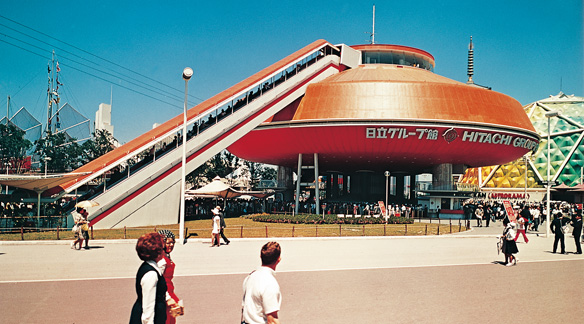
The eye-catching Hitachi Group Pavilion with a 40-meter aerial escalator
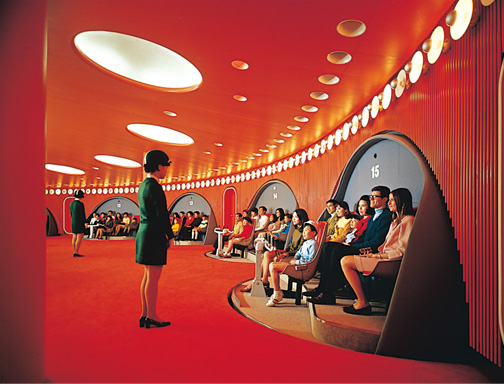
"Simulated Travel" with a simulator for flight training
The Hitachi Group Marine Library was a new style of video library. Films recorded around the world could be selected and watched freely using a video system. The videos were divided into four themes: "Sea and Earth," "Sea and Life," "Sea and Humanity," and "Sea and Romance." Each theme was further divided into ten programs with extensive content such as the creation of earth, mysteries of the sea floor, a humorous ecology of marine life, adventurers in the Age of Discovery, and human history and dreams related to the sea. The facilities in the pavilion were divided by theme, each with six TV monitors. Each pit had a program display panel and a control panel that let the visitors know the current and next programs at a glance.
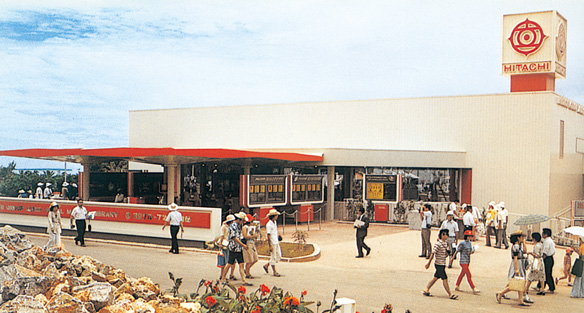
Hitachi Group Marine Library. Iejima could be seen from the windows.
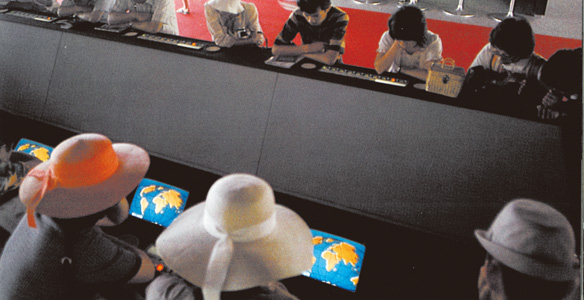
Visitors enjoyed the content they wanted.
The theme of the Hitachi Group Pavilion was "Interface—Free Dialog with Technology." Hitachi believes that it is important for anyone to be able to use advanced technologies freely, and the results of that were brought together to show the fun of science. Interface Plaza on the first floor was full of events where visitors could learn about Hitachi's advanced technologies. At the Robot Art Corner, robots tackled ice-carving challenges in a fun show. At the Electronic Photography Corner, visitors enjoyed a surprising video experience by becoming the hero in a Western film or playing in an anime world. And at the News Media Corner, visitors were able to view the latest news on the latest media equipment of the time. In Interface Theater on the second floor, visitors could enjoy four shows in four theaters without moving from their seat. A fantastic show of light and sound using Hitachi's cutting-edge laser technology was put on at the Approach Theater. At the first theater, a musical show with robots and images showed how humans create and use their tools and machinery. At the second theater, an animation introduced how a prosperous life in near future could be realized by Hitachi's technologies. At the third theater, visitors were able to experience a fantastical and exciting space traveling simulation made possible by the world's first 3D color computer graphics techniques.
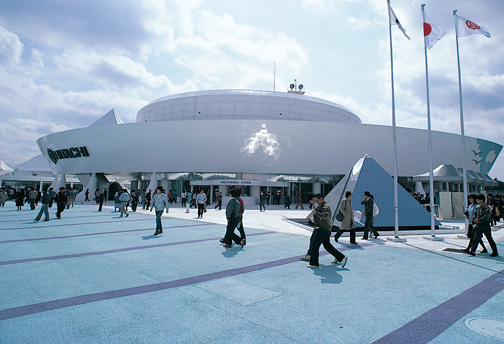
Conical pavilion with a circular rotating theater
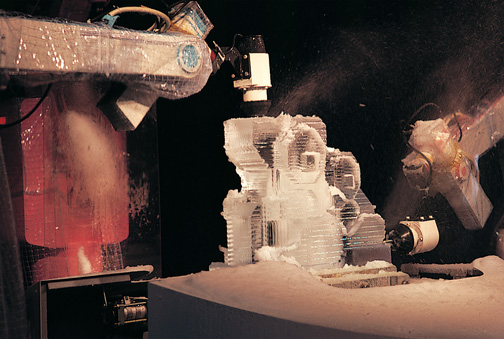
Ice sculpture show by robots
The Hitachi Group Pavilion, Nature Contact, consisted of three stages: the Pre-Show, Main Show and Post-Show. First, visitors would receive the Nature Viewer, an information display device, and begin their journey to meet endangered animals. The device showed video content and text information about 50 endangered animals that are at risk of extinction. When the Nature Viewer was placed close to a pole with illustrations of animals placed in various locations, information about endangered animals was displayed, letting visitors experience a ubiquitous world. At the Post-Show, visitors could have their photos taken at the Main Show displayed on a large display by placing their entry ticket on a ubiquitous display.
In addition, the tickets to Expo 2005 Aichi, Japan contained the μ-Chip, one of the world's smallest ultra-compact IC chips developed by Hitachi.
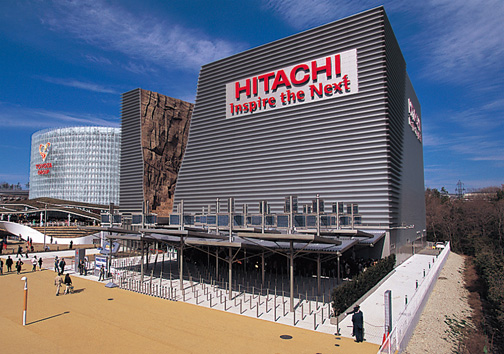
Hitachi Group Pavilion with double-sided photovoltaic solar panels installed

Main show featuring a ride with an MR experience